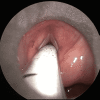Bilateral Vocal Cord Fibrosis: A Delayed Complication of Button Battery Ingestion
- PMID: 35812605
- PMCID: PMC9262087
- DOI: 10.7759/cureus.25721
Bilateral Vocal Cord Fibrosis: A Delayed Complication of Button Battery Ingestion
Abstract
A 14-month-old girl initially presented to the Accident and Emergency (A&E) department following a choking episode and subsequent vomiting. The child left the department before being seen but re-presented the following morning with stridor, drooling, and increased work of breathing. A chest and lateral neck soft tissue X-ray performed in the A&E department revealed an ingested button battery in the oesophagus. Emergency oesophagoscopy was performed and a 22 mm button battery was removed from the oesophagus at the level of the cricopharyngeus muscle, with no immediate complications. Following extubation, the patient was initially well but later required a prolonged hospital stay due to recurrent episodes of stridor, voice changes and aspiration pneumonia. Follow-up microlaryngoscopy and laryngeal electromyography (EMG) diagnosed bilateral vocal cord palsy and cricoarytenoid fibrosis. This case highlights the need for increased public awareness, urgent diagnosis and standardised management of battery ingestion, and discusses the potential for the development of serious latent complications.
Keywords: bilateral vocal cord paralysis; caustic ingestion injury; electromyography (emg); paediatric otorhinolaryngology; paediatric surgery.
Copyright © 2022, Banhidy et al.
Conflict of interest statement
The authors have declared that no competing interests exist.
Figures
References
-
- Emerging battery-ingestion hazard: clinical implications. Litovitz T, Whitaker N, Clark L, White NC, Marsolek M. Pediatrics. 2010;125:1168–1177. - PubMed
-
- Button battery ingestion in children. Eliason MJ, Ricca RL, Gallagher TQ. Curr Opin Otolaryngol Head Neck Surg. 2017;25:520–526. - PubMed
-
- Undetected button and coin cell battery ingestion in children. [ Jun; 2022 ];Healthcare Safety Investigation Branch. UNDETECTED BUTTON AND COIN CELL BATTERY INGESTION IN CHILDREN [Internet. https://www.hsib.org.uk/investigations-and-reports/undetected-buttoncoin... 2019 6
-
- Pediatric button battery injuries: 2013 task force update. Jatana KR, Litovitz T, Reilly JS, Koltai PJ, Rider G, Jacobs IN. http://10.1016/j.ijporl.2013.06.006. Int J Pediatr Otorhinolaryngol. 2013;77:1392–1399. - PubMed
-
- Pathophysiology of esophageal impairment due to button battery ingestion. Völker J, Völker C, Schendzielorz P, et al. Int J Pediatr Otorhinolaryngol. 2017;100:77–85. - PubMed
Publication types
LinkOut - more resources
Full Text Sources




